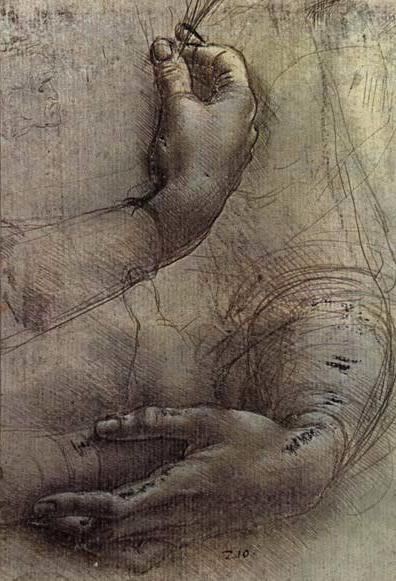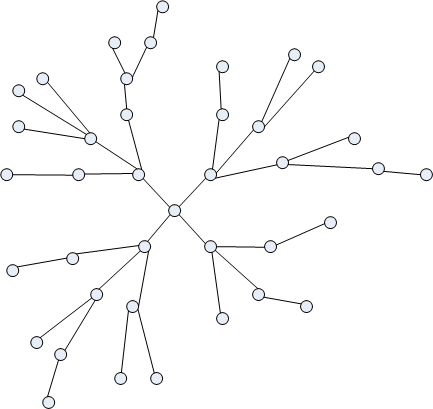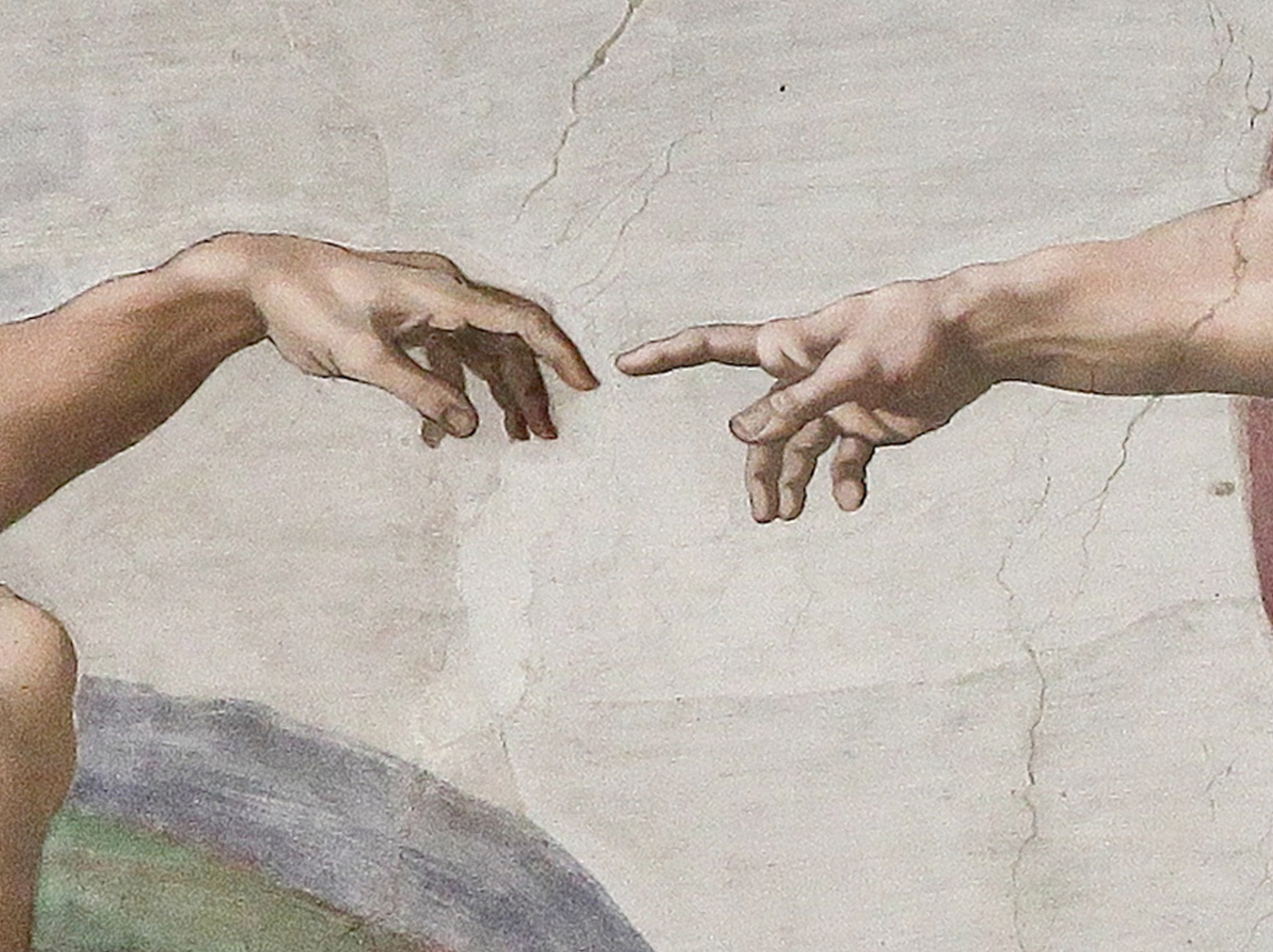
Steel sculpture based on Leonardo's Vitruvian Man, Stockholm. [Philip Hind].
2013 June 6
PART 2: Poincaré's words are in boldface.

If this intuition of distance, of direction, of the straight line -- if this direct intuition of space, in a word -- does not exist, whence comes our belief that we have it?
If this is only an illusion, why is this illusion so tenacious? It is proper to examine into this. We have said there is no direct intuition of size and we can arrive at only the relation of this magnitude to our instruments of measure. We should therefore not have been able to construct space if we had not had an instrument to measure it; and this instrument to which we relate everything, which we use instinctively, is --

Illustration by "Dysfunctional".
It is in relation to our body that we place exterior objects, and the only spatial relations of these objects that we can represent are their relations to our body. It is our body which serves us, so to speak, as system of axes of coordinates.
For example at one instant α, the presence of the object A is revealed to me by the sense of sight; at another instant β, the presence of another object B is revealed to me by another sense, that of hearing or of touch, for instance. I judge that this object B occupies the same place as the object A. What does this mean?
First it does not signify that these two objects occupy, at two different moments, the same point of an absolute space, which even if it existed would escape our cognition, since between the instants α and β the solar system has moved and we cannot know its displacement. It means that these two objects occupy the same relative position with reference to our own body.

But even this, what does it mean? The impressions that have come to us from these objects have followed absolutely different paths, the optic nerve for the object A, the acoustic nerve for the object B. They have nothing in common from the quantitative point of view. The representations we are able to make of these two objects are absolutely heterogeneous, irreducible one to the other.
Only I know that to reach the object A, I have merely to extend the right arm in a certain way. Even when I abstain from doing it, I represent to myself the muscular and other analogous sensations which would accompany this extension, and this representation is associated with that of the object A.
Now I likewise know I can reach the object B by extending my right arm in the same manner, an extension accompanied by the same train of muscular sensations. And when I say these two objects occupy the same place, I mean nothing more.
I also know I could have reached the object A by another appropriate motion of the left arm, and I represent to myself the muscular sensations which would have accompanied this movement; and by this same motion of the left arm accompanied by the same sensations, I likewise could have reached the object B.
And that is very important, since thus I can defend myself against dangers menacing me from the object A or the object B!

With each of the blows that can hit us, nature has associated one or more parries which permit of our guarding ourselves. The same parry may respond to several strokes ; and so it is, for instance, that the same motion of the right arm would have allowed us to guard at the instant α against the object A and at the instant β against the object B. Just so the same stroke can be parried in several ways, and we have said, for instance, the object A could be reached indifferently either by a certain movement of the right arm or by a certain movement of the left arm.
All these parries have nothing in common except warding off the same blow, and this and nothing else is meant when we say they are movements terminating at the same point of space. Likewise, these objects, which we say occupy the same point of space, have nothing in common, except that the same parry guards against them.

Or, if you choose, imagine innumerable telegraph wires, some centripetal, others centrifugal. The centripetal wires warn us of accidents happening without; the centrifugal wires carry the reparation. Connections are so established that when a centripetal wire is traversed by a current this acts on a relay and so starts a current in one of the centrifugal wires, and things are so arranged that several centripetal wires may act on the same centrifugal wire if the same remedy suits several ills, and that a centripetal wire may agitate different centrifugal wires, either simultaneously or in lieu of one another when the same ill may be cured by several remedies.
This complex system of associations, this table of distribution, so to speak, comprises all our geometry, or, if you wish, all in our geometry that is instinctive. What we call our intuition of the straight line or of distance is the consciousness we have of these associations and of their imperious character. It is easy to understand whence comes this imperious character itself. An association will seem to us by so much the more indestructible as it is more ancient. But these associations are not for the most part conquests of the individual, since their trace is seen in the new-born babe; they are conquests of the race. Natural selection had to bring about these conquests the more quickly, the more necessary they were.

On this account, those of which we speak must have been among the earliest in date, since without them the defence of the organism would have been impossible. From the time when the cellules were no longer merely juxtaposed, but were called upon to give mutual aid, it was needful that a mechanism be organized analogous to that we have described, so that this aid would not miss its way, but forestall the peril.
When a frog is decapitated, and a drop of acid is placed on a point of its skin, it seeks to wipe off the acid with the nearest foot, and if this foot be amputated, it sweeps it off with the foot of the opposite side. Here we have the double parry of which I have just spoken, allowing the combating of an ill by a second remedy, if the first fails.
It is this multiplicity of parries, and the resulting coordination, which is space.
We see to what depths of the unconscious we must descend to find the first traces of these spatial associations, since only the inferior parts of the nervous system are involved. Why be astonished then at the resistance we oppose to every attempt to dissociate what so long has been associated ? Now, it is just this resistance that we call the evidence for the geometric truths. This evidence is nothing but the repugnance we feel toward breaking with very old habits which have always proved good!

EDITOR'S NOTES:
So much for the traditional claim that mathematics is the way to Absolute Truth! Growing scepticism about the reliability of mathematics, culminating in Gödel's Theorem and its various cousins, marked the transition from the Nineteenth to the Twentieth Centuries. Obviously, this grew out of the same millieu as the Copenhagen Interpretation of quantum mechanics and the anti-rational trend of Modernism in the arts and humanities. Historians (and intellectuals of the time) have indeed considered this Zeitgeist to mark the coming of the new century, the Age of Uncertainty. I would suggest it is more correctly viewed as the last stage of the Nineteenth, the collapse of the old values before anything new came to replace them. Despite all the lip-service paid to the various "revolutionaries" of the early 1900s, and despite all the ways in which their work outwardly shaped the course of later history history, their philosophical influence on later generations was slight, and especially so in the sciences. This can be seen most clearly in physics (from the hostile, even incredulous, reaction of the post-War establishment to the handful of people who actually wanted to discuss and test the Copenhagen Interpretation rather than assent to it and then completely ignore it -- David Kaiser's How the Hippies Saved Physics documents this phenomenon in the 1970s, but earlier examples could easily be found). It was true, however, in many other disciplines as well, and mathematicians under the spell of "Bourbaki" did not seem greatly troubled by their nominal belief that some propositions are forever undecidable.
The Twenty-first Century mood is somewhat different, and both the questions which troubled the last Nineteenth-Century thinkers and the answers those thinkers proffered are again under discussion. In an age when biology has displaced physics as Queen of the Sciences, the voices of biologists are naturally among the loudest, and what at least some of those voices are saying is quite like what Poincaré said over one-hundred years ago: "geometry" and mathematical or rational truth generally constitute a shorthand for a collection of physiological responses which are favoured by natural selection. Organisms which respond to stimuli with appropriate responses from the collection -- for example, those which interpret a particular series of distance measurements as meaning that a predator is "getting closer" and act to increase the value of this distance-to-predator function-- survive; those which do not, perish.
This view is open to an obvious objection: out of all the possible collections of stimulus-response pairings, only certain combinations enhance survival, and these combinations must work for a reason. Is not this reason that there exists an objective something called, for example, "distance"?
Poincaré, at least in the present essay, thinks not, as we will see.
(We have already noted that Poincaré was influenced by the writings of Joseph Delbœuf; this is true here also. His ideas about the biological origins of space are broadly similar to those found in Part III, Chapter iii of Delbœuf's Psychologie comme science naturelle [Paris: Baillière, 1876], which so far as I know remains untranslated into English.)
THE RELATIVITY OF SPACE, by Henri Poincaré